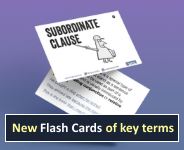Glossary: cohesive device
Explanation
Cohesive devices are words used to show how the different parts of a text fit together. In other words, they create cohesion.
Some examples of cohesive devices are:
- determiners and pronouns, which can refer back to earlier words
- conjunctions and adverbs, which can make relations between words clear
- ellipsis of expected words.
- Julia's dad bought her a football. The football was expensive! [determiner; refers us back to a particular football]
- Joe was given a bike for Christmas. He liked it very much. [the pronouns refer back to Joe and the bike]
- We'll be going shopping before we go to the park. [conjunction; makes a relationship of time clear]
- I'm afraid we're going to have to wait for the next train. Meanwhile, we could have a cup of tea. [adverb; refers back to the time of waiting]
- Where are you going? [_] To school! [ellipsis of the expected words I'm going; links the answer back to the question]
Englicious contains many resources for English language in schools, but the vast majority of them require you to register and log in first. For more information, see What is Englicious?

